NASA’s next crewed spacecraft is now under development and represents a return to the design philosophy of the Apollo era. Stuart Nathan reports
Since the last flight of the Space Shuttle in 2011, there has only been one way to get humans into space: the Soyuz system, using the capsule design that has been in operation since 1968 with only minor changes; the most recent was in 2010 and that module was intended to go out of service the following year. It’s a highly reliable system, but a Soyuz is nobody’s idea of a comfortable place. As those who have visited the Cosmonauts exhibition at London’s Science Museum will know, it’s so cramped that its crew can’t even sit with their legs extended during launch and re-entry. And it can’t get beyond low-Earth orbit.
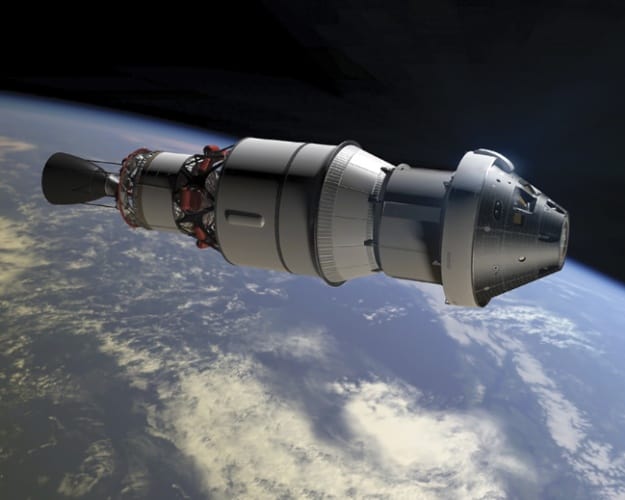
NASA’s next crewed spacecraft, Orion, is under development. It passed one major milestone in 2015 with the first flight of a functional model of its crew capsule into Earth orbit and its successful return, and has reached a second with the start of testing of structural test models of its major components, the crew module and service module.
As this implies, Orion represents a return to the design philosophy of the Apollo era. Rather than design another fully reusable system such as the Shuttle, NASA has opted to save money by going for the older, less complex design.
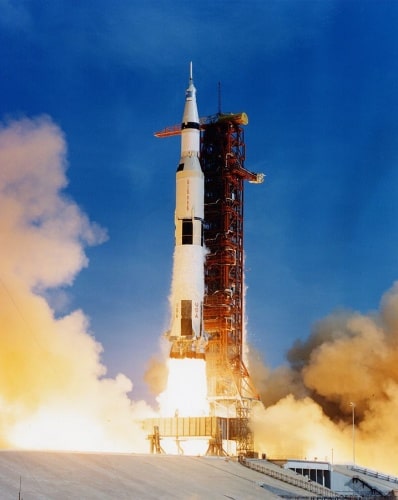
Like Apollo, Orion consists of a cylindrical service module that houses the craft’s propulsion system, along with air and water for up to four crew, who will sit in a command module in a frustum (truncated cone) shape whose base is a heat shield to protect the crew during re-entry. “This is a design and a shape that we can be completely confident will work,” said Mike Kirasich, NASA’s programme manager for Orion at the agency’s Johnson Space Centre in Houston at an event to welcome the structural model of the service module to NASA’s test site in Sandusky, Ohio.
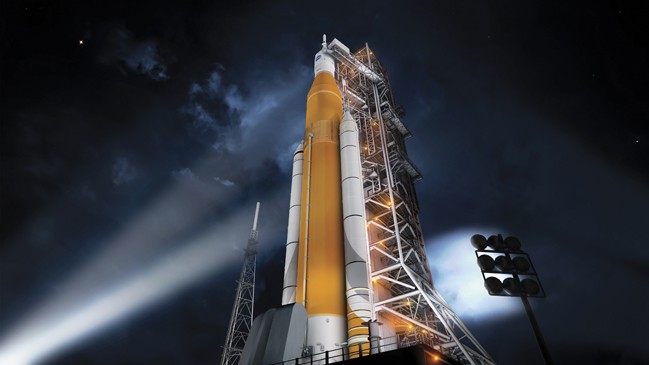
The Service Module is being supplied by the European Space Agency; the first time NASA has collaborated with the outside agency on a crew-carrying spacecraft. The collaboration is part of the agreement covering the International Space Station, to which ESA contributes ‘in kind’ rather than by financial payments.
The European Service Module (ESM) is based on the Automated Transfer Vehicle (ATV) or ‘Space Truck’, the unmanned craft developed by ESA to resupply the ISS, of which five were built; originally ESA hoped to develop this directly into a crewed craft – the agency’s first – but abandoned this plan when the opportunity arose to become part of the Orion project.
It makes much more sense for a project with this scope to be a collaboration with different nations - Oliver Junkenhöfel
This, explained Oliver Junkenhöfel, ESM project manager at Airbus Defence and Space, which is building the module at its Bremen plant, made financial and operational sense. “When the Constellation programme [the forerunner to Orion] was cancelled in 2009 and NASA abandoned the idea of building the entire spacecraft itself, we had a system that had all the component functions. It makes much more sense for a project with this scope to be a collaboration with different nations, and we’ve already proved with the ISS that such multi-agency projects with equipment made in different places that has to interface together not only work, but can flourish.”
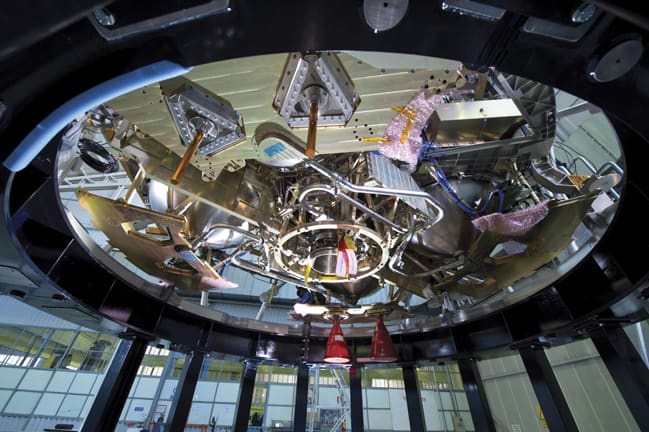
The scope Junkenhöfel referred to is that Orion is intended for the first time since Apollo to take humans beyond the nursery slopes of low-Earth orbit. Its ultimate goal is to take humans to Mars, but it will also be a vital component of plans to return to the Moon and to send humans to an asteroid that NASA hopes to capture, bring back from the Asteroid belt to within the orbit of Mars and ultimately ’park’ in lunar orbit in the coming decades.
In size terms it’s been compared with a limousine in comparison to the ‘sub-compact’ scale of Soyuz; the crew module is 5m in diameter with almost 9m3 of habitable volume; by comparison Soyuz has 5m3 of volume (with only 2.5m3 in the re-entry and launch module) and Apollo was 3.9m in diameter with 6.2m3 of usable volume. Even so, crew would not be expected to remain in such a small space during the 16-month journey to Mars. The current mission profile envisions a habitation module, based on units of the ISS and equipped with a cargo module and its own liquid-fuelled propulsion system, to be assembled in space and to dock onto an Orion module to form the spacecraft that would visit the Red Planet in a 500-day mission. “We would also locate any electronic equipment that needed shielding in these areas.
Space Launch System is new workhorse for Orion
No spacecraft makes it into space without a launcher and for Orion NASA is pulling out all the stops. The first test mission saw the craft sent into space on the agency’s biggest current workhorse, the Delta IV heavy rocket, but subsequent launches will use a brand-new giant, the Space Launch System (SLS). Designed to be modular and expandable, SLS will have a variety of configurations, ranging in size and power from sufficient to get the capsule to the low-Earth orbit of the International Space Station to a Saturn V-matching version to get it to the Moon, and a truly enormous version earmarked for Mars missions (although the size and power here is to get the large components of habitation pods into space; not to get them all the way to the Red Planet, of course).
And like Orion, SLS is a mix of Apollo-era experience and Space Shuttle-derived technologies. Rather than carrying all the rocket power needed to escape Earth gravity inside the first stage, SLS will use solid-fuel boosters attached to the sides of the launcher like the Shuttle, which will be jettisoned early in the flight (and unlike Shuttle boosters, not recovered for reuse).
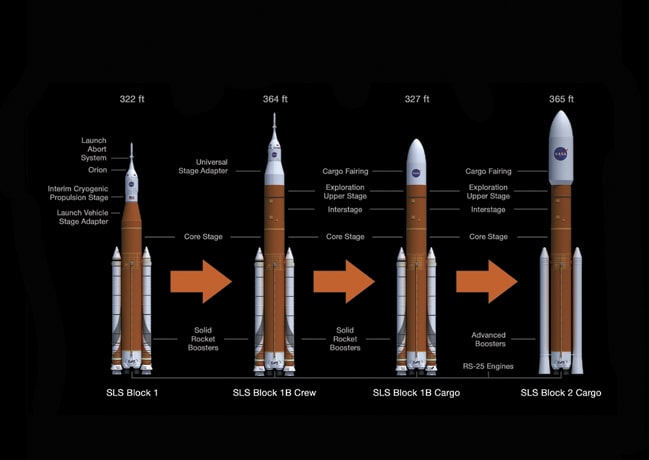
For the ‘block one’ SLS configurations, that are designed for missions to lunar space, these will be derived directly from Shuttle boosters, although NASA plans to develop a new system for the largest configurations, to fly after the late 2020s. And again, like Orion, Shuttle propulsion is being used; SLS’s four main engines will, for its first four flights, be the 16 left over and reconditioned RS-25D Shuttle main engines (the three large engines on the back of the Spaceplane that fired on launch), with later flights shifting to a simplified, purpose-built design not capable of being reused (and the first 16 engines, which have already been used several times, will be discarded after use on SLS).
NASA awarded a contract to Aerojet Rocketdyne (see box below) last November to restart production of RS-25D engines, with the contract running up to 2024. It will take five to six years to build and certify the first of the new engines under this contract.
Shuttle heritage doesn’t stop with propulsion; the first stage of early versions of SLS will in fact be made from the left over external fuel tanks from the Shuttle programme. The upper-stage engines will be the type used as main engines in Delta IV launchers, of which there will be four. This version of the rocket is set to make its first flight in 2021.
Orion is essentially a ‘space taxi’ to take crew to such missions and then return them to Earth,” Junkenhöfel explained. “In that sense, it’s rather fitting that it’s partly based on the Space Truck.” The habitation module would contain ‘refuges’ where crew would be shielded from the high radiation fluxes that exist beyond the Earth’s magnetosphere and through which the craft would travel on the way to Mars. “It makes more sense to build these radiation-hardened areas than to shield the whole structure, which would add too much mass,” explained Kirasich. “We haven’t determined yet what materials we would use,” he added; it has been proposed that part of the craft’s water supply could be used, as water is good at absorbing radiation.
The Orion crew capsule is designed to be reusable to reduce the costs of crewed space missions, and, as such, it incorporates several elements of Space Shuttle technology, notably in its heat shield. Apollo’s was partially destroyed during re-entry and could not be replaced. Orion’s is ablative but replaceable; the largest ever built, it is over 5m in diameter and made from a single piece of a material called Avcoat, composed of silica fibres in an epoxy resin that fills voids in a fibreglass-phenolic honeycomb structure. A new heat shield will be manufactured and fitted for each Orion mission. The heat shield was tested during Orion’s 2015 flight and its manufacture has since been streamlined and simplified, as has the construction of the crew capsule itself, which now requires fewer welds.
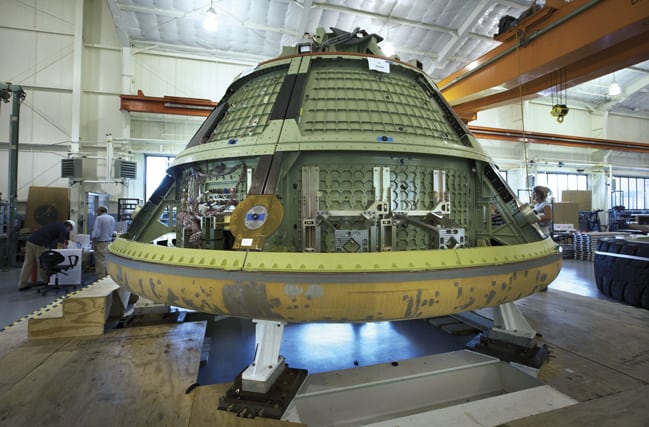
Shuttle technology is also being used for the ESM, in the shape of its main engine, which is an orbital manoeuvring engine left over from the Shuttle programme. This wasn’t one of the three big main engines from the orbiter, explained ESA development department head Nico Dettmann, but was one of the engines coated in pods on either side of the Shuttle’s tail and burned to help the craft into orbit once the launch boosters had detached, positioned the Shuttle in its mission orbit and kicked it out of orbit at the end. The other engines on the module, located around its circumference, are mainly for manoeuvring and have a combined thrust equivalent to the main engine; an example of design redundancy for safety, according to Junkenhöfel.
A major and visible change from Apollo-era technology is the presence of solar panels on the ESM, which will power all the electrical systems on Orion, including all the pumps for fuel, air and water and the electronics in the crew module. Apollo used fuel cells for electrical power.
This should be a goal for all mankind
Orion’s next flight will be in 2018. Called Exploration Mission-1 (EM-1), the craft will be sent without a crew on a trip out of low-Earth orbit, though cislunar space, into orbit around the Moon and then back to Earth. This will provide the programme team with an opportunity to test all the systems aboard without endangering any people and qualify the comparatively few new technologies used in the spacecraft systems (see box above). ESA’s contract to produce the service module only covers this mission, but NASA has invited the agency to continue on the programme and, although a final decision on this will not be taken until the next ministerial meeting of ESA’s governing body, as Dettmann said it expects and is planning to be involved well into the future. Junkenhöfel thinks ESA’s involvement could expand, possibly to include building the habitation modules for a Mars mission. “This should be a goal for all mankind,” he said. “And we know this sort of collaboration works. If India, China, Japan or other nations want to be involved, we should welcome that and there’s no practical reason why they shouldn’t play a part.
Rocketdyne uses 3D printing for Orion capsule engines
Space science is a necessarily conservative business when it comes to technology. It’s almost always seen as preferable to use materials, technologies and processes that are well known for space missions, as the rigours of launch and the environment in space are extreme and the most important thing is to be sure that everything will work. Naturally, this is even more the case where the safety and survival of human beings is concerned.
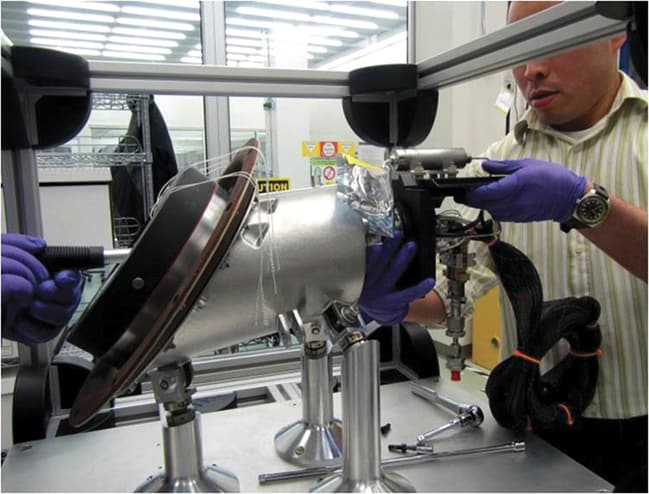
But in Orion, a new technology is being used for key components. Perhaps unsurprisingly, it’s the most prominent of the 21st century’s newest production methods: additive manufacturing. Aerojet Rocketdyne, which has specialised in making the rocket engines that have propelled NASA’s space missions, is using 3D printing to make engines for the Orion capsule.
These aren’t the main engines for the spacecraft, which, as detailed above, come from the tried-and-tested bracket; but the small manoeuvring engines that stud the surface of the crew capsule. Although small (providing just over 700N of thrust each), these serve a vital purpose: their main task is to move and rotate the capsule after it separates from the service module, ensuring it is in the correct orientation for re-entry into the Earth’s atmosphere; give it its final nudge out of orbit and into descent; and keep its orientation stable during re-entry so that parachutes can be deployed safely and effectively. They keep firing even when the parachutes are open to stabilise the capsule so that it’s in the right orientation for splashdown.
The components in question are rocket nozzle extensions, and the reason to use additive manufacturing was to save time, according to Jay Littles, director of Advanced Launch Vehicle Propulsion. The 12 nozzles for a single Orion capsule were all produced on one additive manufacturing machine in three weeks, which is about 40 per cent quicker than using conventional casting methods.
Rocketdyne has been using this technology for some 20 years, said Littles, working on projects with both NASA and the USAF. “What sets us apart from someone just buying a 3D printer is that we understand the process from start to finish, from feed powders, to the optimised machine process parameters, to the resulting material microstructures and material properties,” he said.
The company’s 3D-printed engines have already successfully passed test milestones, with the MPS-120 CubeSat engine, incorporating additively produced titanium pistons and propellant and pressuriser tanks, completing hot-firing tests at the end of 2014.
The new Orion nozzles can’t go straight onto a crewed capsule. In the coming two years, they will undergo numerous rigorous inspections and hot-firing tests, before being installed on the capsule for Exploration Mission-1. The system will therefore have a work-out on the full speed re-entry of an uncrewed capsule returning from lunar space before human lives are entrusted to it.

JLR teams with Allye Energy on portable battery storage
This illustrates the lengths required to operate electric vehicles in some circumstances. It is just as well few electric Range Rovers will go off...